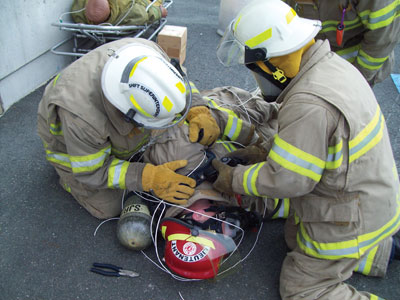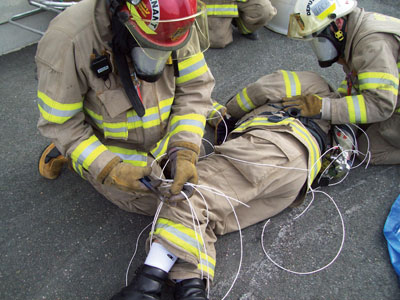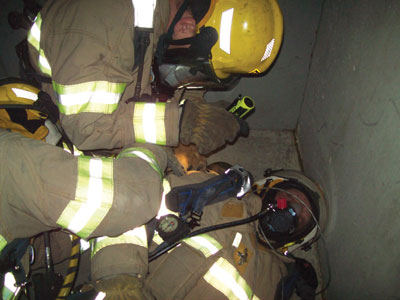
Back to basics: July 2011
Mark Van
Features Fire Ground TrainingWhen a mayday firefighter requires the rapid intervention team, there is a nine-step process that must be followed once contact has been made. The process helps the RIT to quickly assess the situation and the mayday firefighter. The nine steps are as follows:
When a mayday firefighter requires the rapid intervention team, there is a nine-step process that must be followed once contact has been made. The process helps the RIT to quickly assess the situation and the mayday firefighter. The nine steps are as follows:
- locate and turn off PASS device
- radio command
- check breathing
- check pressure gauge
- change bottle/air supply
- check breathing
- check for entrapment
- secure bottle/air supply
- remove firefighter
 |
|
| Photo 1: The noise of the PASS device affects radio communication, so it is essential to locate and silence it as soon as the mayday firefighter has been located. |
|
 |
|
| Photo 2: It’s hard to tell the difference between a wire and a low- or high-pressure air line, so be sure to verify what you are cutting before you make the cut. | |
 |
|
| Photo 3: During assessment, it’s essential to check the air supply of the mayday firefighter. If the air supply is below half, the air supply should be augmented or the air bottle should be changed. If above half, continue using the air in the SCBA until it reaches the halfway mark before changing the bottle or attaching a RIT connection. (Photos by Mark van der Feyst)
|
Locate and turn off PASS device
When the rapid intervention team locates and makes contact with the mayday firefighter, team members will need to quickly locate the PASS device and silence the alarm as seen in photo 1. This will allow RIT members to communicate more easily with command and with one another. The noise of the PASS device affects radio communication and the incident commander will not be able to hear the transmissions. The noise also adds to the overall stress level of RIT members.
Radio command
Command needs to know as soon as contact with the mayday firefighter has been made. The information relayed to command will aid in the overall operation. Requests for additional resources can be made at this time. The status of the mayday firefighter can also be relayed to command. RIT members should pay careful attention to what information is transmitted over the radio regarding the mayday firefighter. Avoid using the name and condition of the firefighter. Instead, relay simple, concise reports to command, such as not breathing, entangled, trapped or buried by debris.
Check breathing
One RIT member will check the breathing status of the mayday firefighter. Putting an ear to the face piece allows a RIT member to hear any air exchange between the SCBA and the firefighter. If there are breathing sounds, then we know that the mayday firefighter is still breathing and we can carry on with the rest of the assessment. If no breathing sounds are present, then a grab-and-go operation should be immediately initiated. Getting the firefighter out of the danger area and providing prompt medical attention is the priority at this point.
Check pressure gauge
RIT members need to check the air-supply status of the mayday firefighter as shown in photo 3. Checking the bottle gauge will tell you how much air is available and will provide a true picture of how much air is left. Checking only the chest gauge can result in a false reading, particularly if the SCBA is damaged. If the air supply is below half, RIT members should either augment the air supply or change the air bottle. If the air supply is above half, it is best to use up the air supply in the SCBA until it reaches the halfway mark before attaching any RIT kit connection or changing the bottle.
Change air bottle/air supply
With the air supply below half, RIT members need to re-establish the air supply. This can be accomplished either by changing the air bottle over to the RIT kit air bottle, or by connecting the RIT air line to the RIT connector on the back of the SCBA. The deciding factor is whether the SCBA has a RIT connector on the back. If the SCBA has a RIT connection, hooking up the RIT kit will crash fill the SCBA on the mayday firefighter’s back, which may cause the cylinder to rupture. This is not a popular option because of the potential danger.
Check breathing
Once the air-supply issue has been resolved, a RIT member needs to listen for signs of breathing and air exchange between the firefighter and the SCBA, as in the process mentioned above.
Check for entrapment
Another RIT member will need to check the mayday firefighter for entanglements, including wiring, suspended ceiling grid, HVAC equipment, debris, and anything else that may impede removal. Sweep the mayday firefighter from top to bottom to check for any entanglements and carefully remove all entanglements. If using wire cutters to cut away wiring, verify what you are cutting before making the cut, as shown in photo 2. It can be difficult to distinguish between a wire and a low- or high-pressure air line.
Secure bottle/air supply
The air supply that is augmenting the mayday firefighter needs to be secured to the mayday firefighter. Whether using a RIT kit or just a plain SCBA, it needs to be secured before removal can begin. Lay the RIT kit or SCBA in the lap of the mayday firefighter, parallel with his legs. Use a large carabiner to attach the air supply to the SCBA waist strap of the mayday firefighter’s SCBA to ensure that it will not slip.
Remove firefighter
Removing the mayday firefighter can be accomplished in a number of ways. We will look at these different ways in more detail in the coming issues. The important factor to remember is speed and care of removal. The quicker the rapid intervention team removes the mayday firefighter, the better the chance he or she will receive prompt medical attention. Care must also be emphasized; we do not want to aggravate injuries or create new ones for the mayday firefighter.
Practising these nine steps is essential to the success of any mayday firefighter rescue.
Mark van der Feyst is a 12-year veteran of the fire service. He currently works for the City of Woodstock Fire Department in Ontario. Mark is an international instructor teaching in Canada, the United States and India. He is a local-level suppression instructor for the Pennsylvania State Fire Academy, an instructor for the Justice Institute of British Columbia and a professor of fire science at Lambton College. E-mail him at Mark@FireStarTraining.com.
Print this page